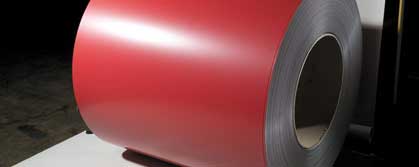10 Signs To Consider Prepainted Metal

Converting from in-house post-painted metal to outsourced prepainted metal can save manufacturers cost, time, and hassles. Here are 10 indicators that a manufacturer should consider using prepainted steel or aluminum:
1) In-house paint shop expenses are growing. When maintenance budgets are growing and plant capital expenditures are being made in order to comply with ever more strict EPA regulations, prepainted metal and aluminum is often a cost-effective alternative to in-house paint lines.
2) Internal operating costs need to be lower. Many manufacturers are searching for ways to lower operating costs in order to remain competitive. Through outsourcing the painting process by opting for prepainted metals, factories can eliminate costly in-house paint operations and the associated expenses of manning the line and complying with EPA regulations.
3) Plant capacity must be increased. By outsourcing the painting process, plants are able to eliminate or greatly reduce the footprint of in-house paint shops, generating more floor space for other uses.
4) Coating quality needs to be improved. Coil coated metals are uniformly cleaned, pretreated, painted, and cured as a flat surface, so that the edge-to-edge and side-to-side variability is virtually eliminated. The prepainted part has two coats of paint, tightly bonded to the metal as compared to a post-painted part, which generally has only one coat of paint. In most cases, the prepainted part has paint on both sides, which enhances protection against corrosion, as compared to the post-painted part which is typically only coated on one side.
5) Down-sizing and or combining of plants is taking place. A good time to consider using coil coated metals is when other major manufacturing changes are taking place. Manufacturers can reduce expenses significantly and increase paint quality greatly by outsourcing the painting process. Coil coated metals can be effectively handled, cut with superior corrosion resistance, joined with welding and adhesives, and formed for many uses…all with a beautiful finish.
6) New product models are being considered. Many times, when design changes are being made, a prepainted metal can be specified and the new design can be more cost effective to produce.
7) Manufacturing bottlenecks are reducing productivity. Many delays in the plant are caused due to in-house painting issues, such as the necessary wait time while parts are painted, dried, and cured before moving to the next stage of assembly. These bottlenecks can be eliminated with the use of prepainted metals.
8) It’s time to update or replace the paint line. Capital expenditures can be avoided, and a long-term cost savings enjoyed by choosing prepainted steel and aluminum, rather than refurbishing or replacing a paint line.
9) A strategy of outsourcing is being implemented. In-house painting may not be a core competence, so purchasing prepainted metals is a cost-effective outsourcing option which actually improves the durability of the coating.
10) New fabricating or material handling equipment is being evaluated. When significant changes are made at the plant, it opens an opportunity to improve many aspects of the manufacturing process, including the use of prepainted metal.
In-house paint lines are considered part of a vertically integrated manufacturing facility, but prepainted metal should be considered as an alternative for each of the above ten considerations.


